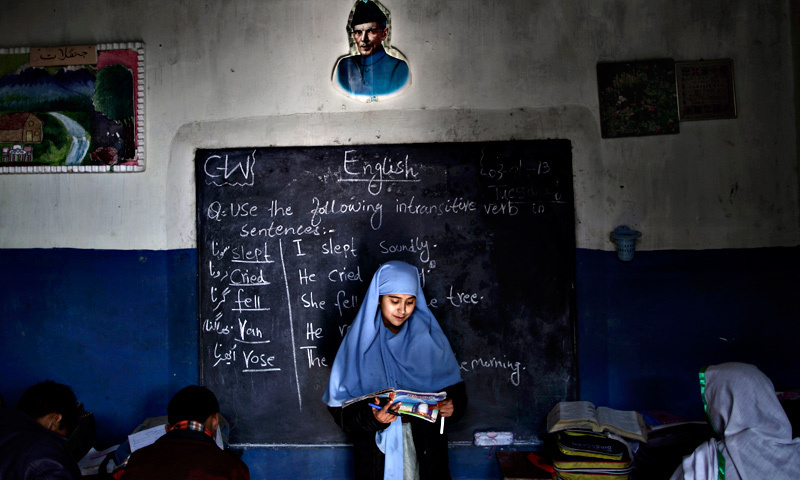The ‘unknown’ state of education

ISLAMABAD: The state of education in Pakistan leaves a lot to be desired, but the situation may be far worse than we currently imagine.
A report on the state of education in the country reveals that the information lawmakers and the general public are given may not be accurate or up-to-date, hindering effective policy making in this key area.
In the recently released Pakistan District Education Rankings 2014, literacy campaigners Alif Ailaan compared the performance of different regions in a bid to assess the overall standard of education in the country.
In the provincial rankings, Islamabad Capital Territory and Punjab were on top, while Balochistan and the Federally Administered Tribal Areas (Fata) came in last.
Lack of timely reporting, inconsistent data make educational policy making an uphill task
The district ranking revealed that most of the best performing areas were from Punjab, while the worst performing regions were located in impoverished Balochistan or Fata.
The rankings accounted for several different variables: enrolment in schools, literacy, learning outcomes, survival rates (how long students stay in school), gender parity, infrastructure and availability of facilities.
Being the second such report prepared by Alif Ailaan, it was interesting to note that six districts had shown anomalous movement in terms of their rankings. Hattian in Azad Jammu & Kashmir went from 115 in 2013 to 28 in 2014; while Kharan and Gwadar in Balochistan climbed 54 and 49 positions, respectively, to move into the top 50.
But this may not be consistent with the situation on the ground.
Hattian Education Officer Noor Muhammad Shah told Dawn the situation was worse in 2013, but some initiatives had been taken to improve the quality of education in the district.
“Teachers have been instructed that to ensure their attendance and their promotions have been linked with their students’ performance. In addition, teachers are being transferred back to their native areas to ensure they are not continuously absent,” he said.
“Hattian’s population is around 400,000 and there are over 300 educational institutions in the district. The administration is trying to ensure that there would be no ghost school in the district,” he said.
In Gwadar, Mohammad Raza, the district officer for Education, told Dawn that last year, a number of schools in the district remained inoperative, hindering enrolment.
“Over the past 12 months, as many as 24 schools have been made functional and seven new ones have been established. Several teachers were apprehensive about taking up their duties, but the education department tied their job security to their attendance, ensuring they would attend,” he said.
“Gwadar has a population of 270,000 spread out over 12,000 sq kilometres. There are a total of 259 government-run educational institutions in the district where around 33,000 students are enrolled. Security issues and frequent violence along the Iran border are our biggest problems here,” he said.
But all is not rosy in the rankings, either.
Swat, which ranked in the top 30 from 2013, slid down to 77 in 2014.
Former Swat Education Director Qasim Jan told Dawn that things were getting worse every year. “The people have no choice but to apprentice their children in workshops because they have to provide for their families. Child labour is up, as is the dropout rate from educational institutions. I fear next year may be even worse than this year,” he said.
“Unemployment is on the rise and skilled individuals are migrating from Swat in search of greener pastures. The government has tried to provide free textbooks to students, but those end up being sold on the market,” he said.
These rankings, which Alif Ailaan says are “an instrument to stimulate a political conversation about education,” are compiled from data from different sources. “Alif Ailaan does not do any primary research,” says team leader Mosharraf Zaidi.
Their objective, he says, is to collect government data that is already available to try and give an evidence base to anecdotal discussions around this key topic.
The data is derived from three sources: the Annual Status of Education Report (Aser), prepared by the Idara-i-Taleem-o-Agahi; the National Education Management Information System (Nemis), managed by the Academy for Education Planning and Management; and the Pakistan Social and Living Standards Measurement (PSLM) survey, carried out by the Bureau of Statistics.
But a major problem with reporting this data is that, in many cases, the information is quite outdated by the time it is made available to the public.
“This year’s rankings, for example, are based on the Aser from 2012 and 2013; the Nemis data from 2011-12 and 2012-13; and the PSLM rankings from 2012-13. This means that by the time the information is analysed and made public, the situation on the ground may not be the same,” said Zaidi.
The government’s data collection and the consistency of that information is also a major area of concern. Dawn spoke to the report’s authors, who admitted that in many cases, the numbers just didn’t add up.
“It may be a case of government officers wanting to send glowing performance reports to their superiors. But the bottom line is, fudging of numbers at any level hurts the cause as it paints an inaccurate picture of the state of education in the country,” a policy specialist involved in preparing the report, told Dawn.
Published in Dawn, July 6th, 2014